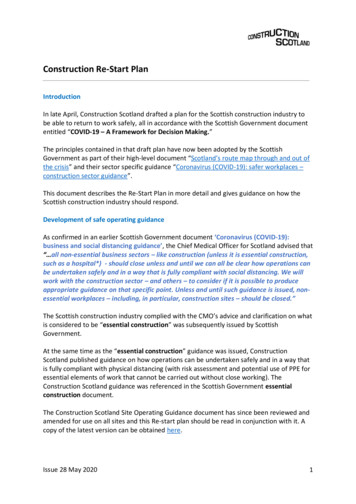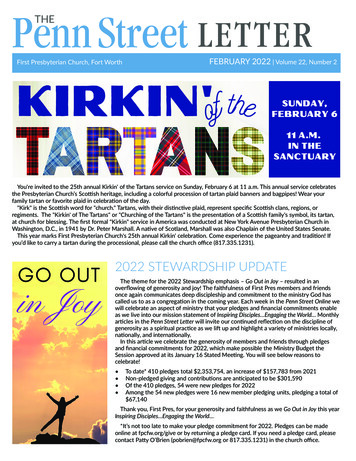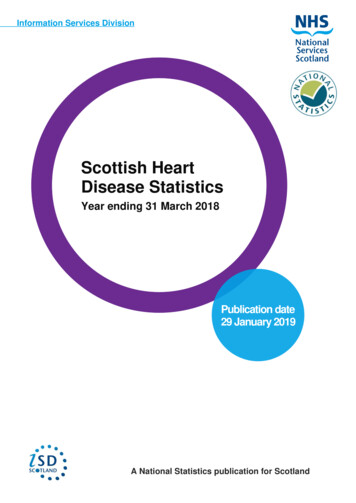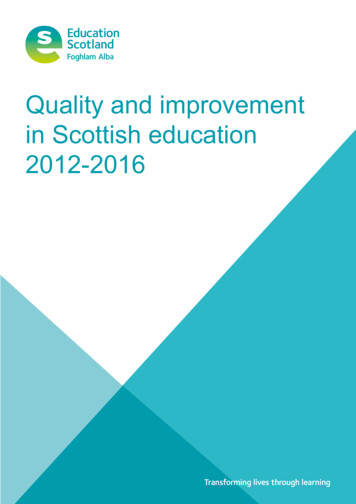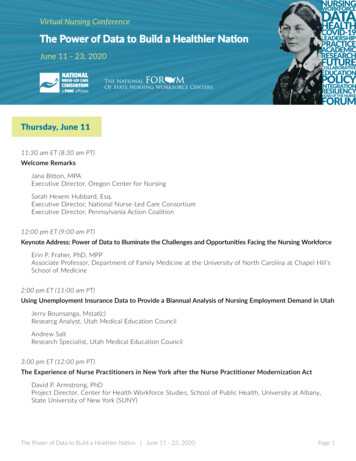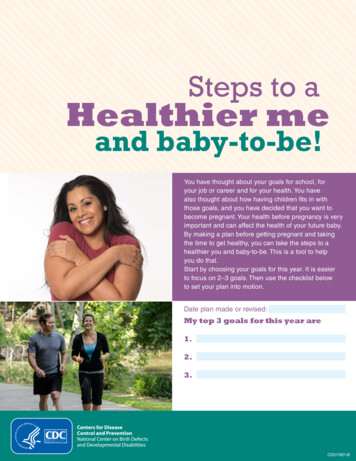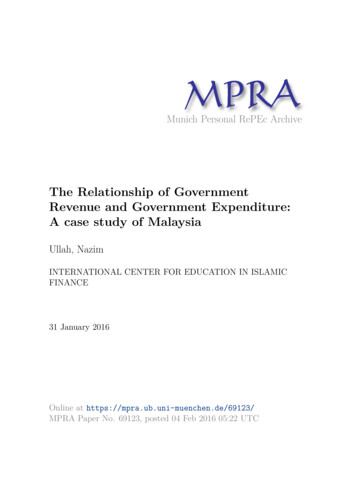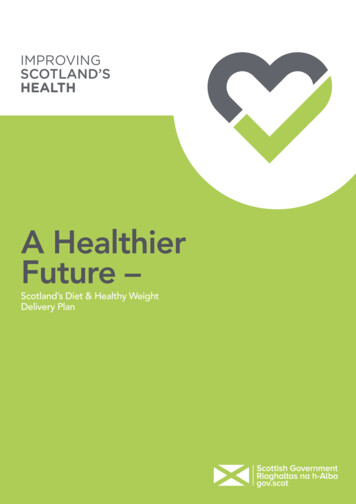
Transcription
A HealthierFuture –Scotland’s Diet & Healthy WeightDelivery Plan
A HealthierFuture –Scotland’s Diet & Healthy WeightDelivery PlanThe Scottish Government, Edinburgh 2018
Crown copyright 2018This publication is licensed under the terms of the Open Government Licence v3.0 exceptwhere otherwise stated. To view this licence, visit /version/3 or write to the Information Policy Team, The NationalArchives, Kew, London TW9 4DU, or email: psi@nationalarchives.gsi.gov.uk.Where we have identified any third party copyright information you will need toobtain permission from the copyright holders concerned.This publication is available at www.gov.scotAny enquiries regarding this publication should be sent to us atThe Scottish GovernmentSt Andrew’s HouseEdinburghEH1 3DGISBN: 978-1-78781-055-6Published by The Scottish Government, July 2018Produced for The Scottish Government by APS Group Scotland, 21 Tennant Street, Edinburgh EH6 5NAPPDAS409386 (07/18)
ContentsPageMinisterial foreword 01The Challenge 03Our Vision and Approach 08Outcome 1: Children have the best start in life – they eat well and have a healthy weight 10Outcome 2: The food environment supports healthier choices 15Outcome 3: People have access to effective weight management services 22Outcome 4: Leaders across all sectors promote healthy diet and weight 26Outcome 5: Diet-related health inequalities are reduced 30Next steps 32Glossary 33
Scotland’s Diet & Healthy Weight Delivery Plan A Healthier Future01Ministerial forewordAs the new Minister for Public Health, Sportand Wellbeing, I welcome the early opportunityto set out my vision and ambition for thispriority area of public health. My plan setsout a challenging agenda and I relish theopportunity to lead its delivery. With broadconsensus in Scotland on the need to act and to be bold and decisive - I am confidentthat together with our public, private and thirdsector partners, we will bring people andcommunities across Scotland with us.Looking after ourselves and the nextgeneration is vital to our nation’s health andour ability to flourish as individuals.Yet far too many people in Scotland face seriousrisks to their health associated with poor dietand unhealthy weight. We have the highestoverweight and obesity levels of any UK nation nor do we compare well with the majority of ourcounterparts in the developed world.This situation is unacceptable – not leastbecause it’s largely avoidable.Change is needed.We won’t shirk from this challenge. Scotlandhas a proud history of taking ambitious andpioneering action on public health. We werethe first in the UK to introduce a smoking banin public places, and we recently becamethe first country in the world to introduce aminimum unit price on alcohol.Now it’s time for a renewed focus on improvingthe nation’s diet and weight.The vision is simple: to create a Scotlandwhere everyone eats well, and we all have ahealthy weight.Giving all children the best possible start inlife is essential to achieving this. The FirstMinister recently announced a pledge to halvechildhood obesity by 2030, and I’m proud thather ambition sits at the heart of this deliveryplan.But this is also a plan for everyone in Scotland,consistent with our vision for a nation wherewe can all enjoy our right to the highestattainable standard of health. Many of usneed to pay attention to our diet and weight,although it is sobering to see that a far higherproportion of people in our most deprivedcommunities are obese compared to thosein more affluent areas. I’m clear that we mustdo more to support those who need it most,so they feel empowered and enabled to makehealthier choices. That’s why we will seek tosignificantly reduce health inequalities, taking ahuman rights based approach.Making the improvements we need to seerequires decisive action – and a new foodculture.Government alone cannot achieve this.Change happens in our homes andcommunities, in the places where we eat, liveand work, and through the lives we lead. Inall these places we must - together - make iteasier to eat well and have a healthy weight.Achieving changes also requires a joined upapproach to food, where Scotland continuesto grow as a Good Food Nation and wheregood, affordable, locally sourced food is atthe heart of our efforts to ensure everyone inScotland has a healthy diet. Our commitmentto being a Good Food Nation stands tomake a very substantial contribution to ourambitions.
02Scotland’s Diet & Healthy Weight Delivery PlanA Healthier FutureWith the Convention of Scottish LocalAuthorities (COSLA), we have agreed six keypublic health priorities for Scotland. Thesepriorities recognise the significance of leadinghealthy lives, and commit to ‘a Scotland wherewe eat well, have a healthy weight and arephysically active’. COSLA will be a key partnerin the delivery of this plan, and I welcome theirendorsement of its direction of travel.It would be impossible to discuss thenation’s diet and weight and not recognisethe significance of physical activity. Sothis document goes hand in hand with AMore Active Scotland: Scotland’s PhysicalActivity Delivery Plan, soon to be published,for supporting and enabling the people inScotland to become more active.Political consensus is always welcome whentackling important public health issues, andI welcome the cross-party backing fromthe Scottish Parliament for this plan to beambitious in its scope. I look forward to thecontinued support of colleagues as we tacklethis public health challenge.Recognising that some actions can only betaken on a UK-wide level, I want to workconstructively with the UK Government andother devolved administrations to ensurewe achieve the best possible outcomesfor Scotland using all the levers collectivelyavailable to us, including the UK actions in theUK Government’s recent action plan.Since launching our consultation in October2017, there has been significant, positiveresponse to our ambition. I look forward toworking with our many partners to implementthis plan and achieve our bold vision for ahealthier Scotland.JOE FITZPATRICK MSPMinister for Public Health, Sport &Wellbeing
Scotland’s Diet & Healthy Weight Delivery Plan A Healthier Future03The ChallengeThe impacts of poor diet and overweightare profound. They affect not only our health,but also our ability to lead happy, fulfilling lives.They have also led to increased, unsustainabledemand on the NHS and other public services.The Scottish diet remains stubbornlyunhealthy, and we are far from meetingour dietary goals.1 This has a direct impacton levels of overweight and obesity - andtherefore health harm – in the population.These problems start early. Overall, childrenin Scotland tend to consume foods and drinkshigh in fat and/or sugar more often thanadults2 – an alarming finding that indicatesfuture health problems in store. In Scotland,the rates of overweight and obesity for bothchildren and adults are among the highestin the developed world. The 2016 ScottishHealth Survey estimates that 29% of childrenare at risk of being overweight (including at riskof obesity) – of which approximately half (14%)are at risk of obesity specifically.3Children tend to consume foods and drinks highin fat and/or sugar more often than adults:Half eat sweets orchocolates every dayA third eat crispsevery dayA third drink sugary softdrinks every daySource: Public Health Priorities1 Scottish Government (2017), The Scottish Health Survey 2016, volume 1, main report. http://www.gov.scot/Resource/0052/00525472.pdf2 Scottish Government (2017), The Scottish Health Survey 2016, volume 1, main report. http://www.gov.scot/Resource/0052/00525472.pdf3 Scottish Government (2017), The Scottish Health Survey 2016, volume 1, main report. http://www.gov.scot/Resource/0052/00525472.pdf
04Scotland’s Diet & Healthy Weight Delivery PlanA Healthier FutureBeing overweight or obese is now thenorm for Scottish adults. Two-thirds (65%)of adults are now overweight, with almost onethird (29%) obese.4Scottish Health Survey 2016: ObesityTwo thirds(65%) of adults in Scotlandwere overweight, including29%who wereobese, in 2016These figures are largely unchanged since 2008Source: Scottish Health Survey 20164 Scottish Government (2017), The Scottish Health Survey 2016, volume 1, main report. http://www.gov.scot/Resource/0052/00525472.pdf
Scotland’s Diet & Healthy Weight Delivery Plan A Healthier Future05The health harms associated within increased risk of other conditions includingcarrying excess weight are severe. Obesitycardiovascular disease and hypertension.7is the second-biggest preventable cause ofPoor diet and weight often also go handcancer, behind onlyand is linkedImprovingthe smoking,food environmentandhealthier choicesin hand with other risk factors such as lowto around 2,200 cases of cancer a year inphysical activity, smoking and harmful drinkingScotland.5 Being overweight and obese– compounding*is tobetweenparagraph1.2and 1.3 health harms.8alsobetheplacedmost significantrisk factorforandnotedcan resultdevelopingsourcetype 2 diabetes,PleasePHE 6asbelowObesity Harms HealthSource: Public Health EnglandSource: Public Health England5 Katrina F Brown et al (2018) The fraction of cancer attributable to modifiable risk factors in England, Wales, Scotland,Northern Ireland, and the United Kingdom in 2015 http://www.nature.com/articles/s41416-018-0029-66 Hauner H (2010). Obesity and diabetes. in Holt RIG, Cockram CS, Flyvbjerg A et al (ed.) Textbook of diabetes. 4th edition.7 Guh et al (2009) The incidence of co-morbidities related to obesity and overweight: A systematic review and .com/articles/10.1186/1471-2458-9-888 Scottish Government (2017), The Scottish Health Survey 2016, volume 1, main report. http://www.gov.scot/Resource/0052/00525472.pdf
06We know that people who live in moredeprived areas tend to be most impacted.Significant inequalities in levels of obesitypersist between people living in the least andmost deprived groups in Scotland – and thegap may be widening for children.9 Overall,around 32% of adults living in the mostdeprived areas are obese, compared with 20%of those living in the least deprived areas.10As well as health impacts, there aresignificant socioeconomic implications.The annual cost of treating conditionsassociated with being overweight and obese isestimated to range from 363 million to 600million. The total annual cost to the Scottisheconomy of overweight and obesity, includinglabour market related costs such as lostproductivity, is estimated to be between 0.9 billion and 4.6 billion.11Scotland’s Diet & Healthy Weight Delivery PlanA Healthier Future 4.6billionSource: Public Health Priorities9 E Tod et al (2017) Obesity in Scotland: a persistent inequality. International Journal for Equity in Health, 16: 135. https://doi.org/10.1186/s12939-017-0599-610 Food Standards Scotland (2018) The Scottish Diet - It needs to change 2018 update. ion report - the Scottish diet - it needs to change - 2018 update FINAL.pdf11 A Castle (2015) Obesity in Scotland. SPICe Briefing, 15/01. 7 Jan 2015. tsheets/S4/SB 15-01 Obesity in Scotland.pdf
Scotland’s Diet & Healthy Weight Delivery Plan A Healthier FutureThis situation is not sustainable foreither the health of the nation or thehealth service. It is much better for theindividual, society and the health serviceto seek to prevent ill-health occurring inthe first place.Public opinion backs action. Nearly 70%of people believe that obesity harms Scotlandeither ‘a great deal’ or ‘quite a lot’.12 Themajority of people in Scotland are also infavour of at least one intervention to placerestrictions on advertising, sponsorship andpackaging of food and drink high in fat, sugaror salt.1307To make a meaningful impact, we need totackle the factors that encourage us to makeunhealthy choices. Food and drink high in fat,sugar or salt is widely available, and heavilypromoted – in fact, UK consumer expenditureon price promotions is the highest in Europe.14Evidence suggests that, overall, the food anddrink provided out of home is skewed towardsless healthy options.15It’s clear our plans to tackle the Scottishdiet need to be ambitious and decisive.12 NHS Health Scotland (2018) Public attitudes towards reducing levels of overweight and obesity in Scotland ttitudes-to-reducing-obesity-in-scotland.pdf13 NHS Health Scotland (2018) Public attitudes towards reducing levels of overweight and obesity in Scotland ttitudes-to-reducing-obesity-in-scotland.pdf14 Public Health England (2016) Sugar Reduction: The evidence for action. Annexe 4: An analysis of the role of price promotionson the household purchases of food and drinks high in sugar t/uploads/system/uploads/attachment data/file/470175/Annexe 4. Analysis of price promotions.pdf15 Food Standards Scotland (2017). Diet and Nutrition Board Paper. Proposals for setting the direction for the Scottish Diet: Oneyear on: -research/fss-board-meeting-8-march-2016
08Scotland’s Diet & Healthy Weight Delivery PlanA Healthier FutureOur Vision and ApproachOur visionA problem of this scale must be met with anequally ambitious aim, and our vision is for aScotland where everyone eats well and has ahealthy weight. Recognising the specific needto tackle weight-related issues at an early stage,this delivery plan also has an ambition to halvechild obesity in Scotland by 2030. We are alsoaiming to significantly reduce health inequalities.OutcomesThis vision will be achieved by workingtowards five key outcomes:4 Children have the best start in life - they eatwell and have a healthy weight4 The food environment supports healthierchoices4 People have access to effective weightmanagement servicesThe actions set out in this documentare informed by and form the ScottishGovernment’s response to that consultation.Additionally they are set in the context of theUK Government’s Childhood obesity: a planfor action Chapter 2 published on 25 June.Most of the measures included in the plan arespecific to England. The Scottish Governmentwelcomes the actions being taken at a UKlevel, which complement the actions outlinedin this delivery plan.Our overall approach is underpinned by thepublic health reform principles to which weand COSLA have committed.16 And we willencourage our partners and those workingwith us across Scotland to reflect similarprinciples in all that they do. It is also shapedby the following cross-cutting principles:4 Diet-related health inequalities are reducedEvidence-based interventionsWe are committed to policy and action whichis grounded in the evidence. This means wewill continue to evaluate our actions and theirimpact. We will consider the case for additionalmeasures, where the evidence supports this.Our approach and principlesIn developing this plan, we have listened to awide range of views: over 360 stakeholders andindividuals responded to our 2017 consultation(A Healthier Future – Action and Ambitionson Diet, Activity and Healthy Weight) andover 630 people attended our engagementevents. There was broad consensus, if not onevery proposal, that overweight and obesity aresignificant and serious public health problemsthat require ambitious action.Population-wide measuresThe main focus of this delivery plan is theimplementation of population-wide interventionsto change the environment, which will impacteveryone in Scotland - learning from theexperience of successful public health policies,such as the ban on smoking in public places.Evidence suggests that population-wideinterventions are likely to be more effective inreducing inequalities as they do not rely onindividual behaviour change.174 Leaders across all sectors promote healthyweight and diet16 Scottish Government (2018) Scotland’s Public Health Priorities http://www.gov.scot/Publications/2018/06/139317 Macintyre, S. (2007) Inequalities in health in Scotland: what are they and what can we do about them. Other. MRC Social and PublicHealth Sciences Unit. hem
Scotland’s Diet & Healthy Weight Delivery Plan A Healthier FutureTargeted measuresSitting alongside our population-wideapproach, is delivery of targeted and tailoredsupport specifically to those children andfamilies who are most at risk.Reducing inequalitiesA key outcome of this delivery plan is toreduce diet-related health inequalities, taking ahuman rights based approach to ensure thatwe are supporting those most in need. It iscrucial too that our stakeholders and deliverypartners place a special emphasis on reducinginequalities when planning, designing anddelivering interventions – including throughthe co-design of services and support wherepossible.Joined up policyRecognising that the causes of overweightand obesity are complex, multi-faceted andshaped by a broad range of factors, our planfor improving diet and weight sits alongsidea wide range of government policy andaction. It is one of five linked public healthstrategies being published this year for AlcoholPrevention, Substance Use, Tobacco Control,and Physical Activity. In particular, physicalactivity has an important role in weightmanagement, and this delivery plan should beread alongside the forthcoming: A More ActiveScotland: Scotland’s Physical Activity DeliveryPlan.Beyond public health, we also seek coherenceacross a range of other policies and areas.These include action on welfare reform andchild poverty. This delivery plan also aligns toour ambitions for Scotland as a Good FoodNation, and well-established frameworksfor improving children and young people’s09outcomes. The Maternal and Infant NutritionFramework; Getting it right for every child;Better Eating, Better Learning; Curriculumfor Excellence, with its strong focus onhealth and wellbeing, and proposed changesto school food regulations, are all essentialscaffolding for ensuring continuity of supportto children, young people and their familiesacross all ages and stages.Cross-sector leadershipAmbitions and actions on this scale cannot betaken forward by government alone. Tacklingobesity is a shared responsibility, and centralto the success of this plan will therefore beleadership, collaboration and commitmentacross the public, private, third and communitysectors.The actions in this plan set out how we hopeto achieve our vision.
10Scotland’s Diet & Healthy Weight Delivery PlanA Healthier FutureOutcome 1: Children have the best start in life –they eat well and have a healthy weightHalving childhood obesity in Scotland by 2030is a deliberately bold ambition. With nearlythree in ten children in Scotland at risk of beingoverweight or obese, aiming high is not justdesirable, it is also necessary if children andyoung people are to flourish and lead happy,healthier lives.We also know that early childhood – and, infact, what happens before children are born – isa critical time for establishing good nutrition andhealthy eating habits. If we can achieve this, thelikelihood of children becoming overweight orobese in later life is significantly reduced.Many people are involved in a child’s life –including midwives, health visitors, familynurses, GPs, teachers and school nurses- so it is important they are armed with theknowledge and skills to talk about diet andweight to support children and their familiesto make healthier choices. We also recognisethat all environments where children live, learnand play have an enormous influence on whatthey eat. That includes not just their homebut also early years and childcare settings,schools, shops and retail premises beyondthe school gates, and the wider community.That is why actions right across this plan, notjust those outlined below, will contribute toachieving our ambition for halving childhoodobesity.But fundamentally, we want to ensure parentsand carers are supported to make informeddecisions, whether it’s about breastfeedingand weaning, nutrition, portion size ormealtime behaviours. And should their child’sweight become a concern, we want parentsto understand why it matters, and to feelsupported – not judged - with good adviceand services (see outcome 3).Adolescence is a particularly important stagein a young person’s life when they start tomake more decisions for themselves andare open to many different influences. Thetransition to adulthood can be a challengingtime, with diet and weight among a widerange of factors affecting their health andhappiness. We therefore want to give thisspecific attention, so that young people feelempowered and supported to make healthychoices.Healthy diet and weight before and duringpregnancyThe Scottish Government is determined thatevery child, regardless of their circumstances,should get the best start in life. We want morewomen and their partners, where pregnancy isplanned, to feel supported to take steps for ahealthier pregnancy prior to conception.Action 1.1 By summer 2019, the ScottishGovernment will consult on a pre-conceptionaction plan to improve how services engage,inform and support women before theybecome pregnant to start their pregnancy ata healthy weight, and in good physical andnutritional health. We will raise awareness ofthe importance of pregnancy planning andnutrition, focusing on first pregnancies andhigher risk groups (e.g. women of childbearingage who are known to have weight issues,those who are known to be diabetic andwomen who have previously miscarried).Supporting women to breastfeedThere is strong evidence that breastfeedingis one of the most important things that amother can do to give her baby the bestnutritional start in life and can also be a meansof preventing obesity among infants and young
Scotland’s Diet & Healthy Weight Delivery Plan A Healthier Futurechildren.18,19 However, we recognise that forsome mothers and babies breastfeeding canbe challenging. So, where a mother can, andwould like to, breastfeed her baby for longer(and a majority of women have said theywould), we want to support them to achievethat.20Action 1.2 Building on current infant feedingservices and the best evidence available,the Scottish Government will, over the nextthree years, work with Health Boards and thethird sector to develop services that meet theneeds of women based on their individualcircumstances with the aim of reducing thedrop off in breastfeeding rates at 6-8 weeks by10% by 2025.Advising parents about healthy eating inthe early yearsWe understand that parents want to get itright when it comes to their child’s diet andnutrition, but that sometimes differing advice,for example from other parents and familymembers, can cause uncertainty about thebest things to do. We therefore want to ensurethat parents and expectant parents knowhow and where to access accurate and upto date information on child healthy eatingand lifestyle habits, through discussionswith health professionals, social marketingand by directing parents to a range of onlineresources through Scotland’s Baby Box.11Action 1.3 Building on Eat Better, FeelBetter, Ready Steady Toddler and theParent Club website, email and social mediachannels, the focus of Scottish Government’ssocial marketing activity to March 2020 will beon giving parents practical advice on weaning,and at the ages and stages that follow:toddlers, pre-schoolers, and primary schoolaged children.Action 1.4 The Scottish Government willraise awareness among parents and carers,and the professionals who support them,of the possible longer-term impact of usingsnacks (such as confectionery, sugary drinksand crisps) as rewards for behaving well. Wewill do this through Ready Steady Toddler,the Eat Better, Feel Better campaign andthe Parent Club website. An independentevaluation will be carried out by end of June2021 and used to improve information andadvice.Upskilling frontline staff to supportparents and childrenWe want all parents and carers to feelinformed, supported and empowered whenit comes to making decisions about theirchild’s diet and nutrition. Critical to this isthat all those who play a role in supportingparents, children and young people – frommidwives, health visitors and other healthcareprofessionals, to youth workers, early yearsand school practitioners, teachers andcatering staff – have the knowledge and skills18 The Lancet (2016), Series from the Lancet journals: Breastfeeding https://www.thelancet.com/series/breastfeeding19 World Health Organisation (2016), Final report of the Commission on Ending ChildhoodObesity 4176/9789241510066 eng.pdf;jsessionid 80DB37EF24A06BD1DEF7807332A3C66A?sequence 120 Scottish Government (2018), Scottish Maternal and Infant Nutrition Survey 2017 http://www.gov.scot/Resource/0053/00531610.pdf
12Scotland’s Diet & Healthy Weight Delivery PlanA Healthier Futureto support parents to make healthier choicesfor themselves and their children.Action 1.5 To ensure parents receive themost appropriate advice and support, theScottish Government will in 2018 developtraining on diet, nutrition and healthy weightfor front-line staff across a wide range ofdisciplines working with children, youngpeople and families.Action 1.6 Building on this strongfoundation, we will take further action todevelop the knowledge and skills across theworkforce.-A programme of eLearning andContinuing Professional Developmentwill be introduced in 2018, to ensurefront-line staff across a range ofdisciplines have the knowledge, skillsand confidence to support parents withweaning and toddler diet, includingdiscussing and advising on the timingand introduction of suitable foods basedon the age and stage of the child.-Training for early years practitionersby summer 2019, to support theimplementation of Setting the Tablenutritional guidance and food standards,which will be updated to reflect currentevidence and changes in early learningand childcare (ELC) provision. The CareInspectorate will monitor implementationof this guidance.-Updated resources and tools for GPs,health visitors and the early yearsworkforce in 2019, to equip them toengage with and support families whenweight or nutrition is a concern. This willinclude healthy eating, portion controland mealtime behaviours.-Health and other professionals willhave access to training and supportmaterials in 2020, to enable them torefer children and families to appropriateand supportive diet and healthy weightinterventions such as parenting support,cooking classes, and child healthy weightprogrammes.Children and young people have the skillsthey need to make healthy choicesHealth and wellbeing sits at the heart of theCurriculum for Excellence, supportingchildren and young people to developessential skills to live happy, healthy lives.The promotion of health and wellbeing is,along with literacy and numeracy, identifiedas a responsibility for all practitioners workingwith children and young people in the schoolenvironment. Food and Health Experiencesand Outcomes are an entitlement from ages3-15, supporting children and young people todevelop their understanding of a healthy diet.21In addition, Better Eating, Better Learning(BEBL) currently provides guidance andsupport to schools, local authorities, caterers,procurement departments, parents, childrenand young people to work in partnership tomake further improvements in school food andfood education.2221 Education Scotland, Experiences and outcomes -5%29/Experiences%20and%20outcomes22 Education Scotland, Better Eating, Better Learning tion/Better%20Eating,%20Better%20Learning
Scotland’s Diet & Healthy Weight Delivery Plan A Healthier FutureAction 1.7 Over the course of thisparliament, the Scottish Government willinvest 750 million in the Attainment ScotlandFund to tackle the poverty-related attainmentgap. Local authorities and schools in receiptof this funding include health and wellbeinginterventions as one of three key target areasin their plans for intervention, alongsideliteracy and numeracy. Amongst the variousinterventions made by local authoritiesand schools using this funding, there areprogrammes that include education onhealthy eating and lifestyle as well as someprogrammes that include provision of mealsalongside learning opportunities for childrenand families.Action 1.8 Through the work of theRegional Improvement Collaboratives (RICs),Education Scotland will strengthen and focusthe provision of health and wellbeing supportto schools and authorities across Scotland.The RICs are due to finalise their regional plansby September 2018.Supporting young people to makehealthier decisionsOur young people stand to gain the mostfrom living in a country that strives to createa healthy eating culture. The Year of YoungPeople 2018 is a great opportunity to builda lasting legacy by listening to young peopleand asking them to lead key strands of work.Indeed there are some examples of youngpeople leading change in their communities,such as engaging local retailers to improvethe food on offer near their school. Alongsidethis, our messaging on diet and healthy weightand how it is delivered must be informed byyoung people. We recognise this is particularlyimportant in adolescence when young peopleare making more decisions for themselves.13Action 1.9 Young people will lead changeand action on healthy eating in line withtheir rights and ambitions to lead healthyand active lives. A coalition of the
Page Ministerial foreword 01 The Challenge 03 Our Vision and Approach 08 Outcome 1: Children have the best start in life - they eat well and have a healthy weight 10 Outcome 2: The food environment supports healthier choices 15 Outcome 3: People have access to effective weight management services 22 Outcome 4: Leaders across all sectors promote healthy diet and weight 26
